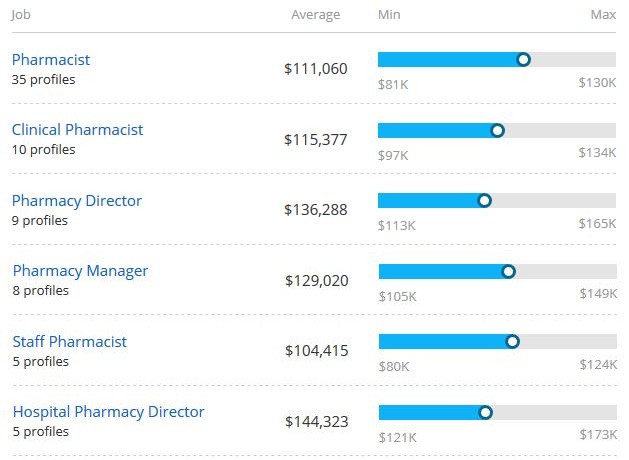How to Become a Pharmacist
This article provides in-depth information into What is a Pharmacist? What Pharmacists do? Degrees for Pharmacists, Steps to become Pharmacist and much more.
Pharmacists are health professionals who have extensive knowledge of medicine to educate patients on effective medication uses. They are also called a chemist or druggist who accurately measures the amount of medicine, its dosage, chemical reaction, safety measure according to the doctor's prescription and counsels the patient on how to take the medications.
Becoming a pharmacist could be the right career for you and here are the steps listed,
- Complete an accredited undergraduate degree
- Earn a relevant graduate degree
- Clear a licensure exam- NAPLEX
- Gain post-doctoral training
- Specialize through residency programs
- Continue education to keep the license active
|
Career Title |
Pharmacist |
|
Degree Requirements |
Doctor of Pharmacy (PharmD) |
|
Job Growth (2018- 2028) |
4% |
|
Experience required |
3-4 years |
|
Salary (2020) |
$135,337 |
|
How long to become a Pharmacist |
10 years |
|
Required Skills |
Attention to Detail, Communication, problem-solving, drug knowledge, team player |
What does a Pharmacist do ?
A pharmacist is an educated individual with a high school degree or post-secondary degree with several hours of clinical experience.
-
Counsel the patients to fill in the prescription and the amount of medication to be taken.
-
Instructing the patients on the dosage, amount of medicine to be taken according to their health condition to avoid chemical reactions.
-
Advice patients on general health, managing stress, exercise to maintain a healthy lifestyle.
-
Perform other administrative tasks to look after the performance of pharmacist interns and technicians
-
Give flu shots and vaccinations( in some states)
-
Manage the inventory of medications, refilling the stock, and its expiry dates.
-
Responding to the patient's queries and educating them with the pros and cons of the medicines.
Steps for becoming a Pharmacist
1
Complete The Relevant Degree Program
This career can be pursued in two different paths to be eligible to land on the job.
-
Undergraduate + Graduate: This is the pre-pharmacy course which is a two or four-year course that allows you to complete the undergrad and then enter into the grad program. This incorporates general education such as organic chemistry, human anatomy and physiology; molecular and cellular biology; microbiology; statistics; calculus; and English. After sufficient coursework, students apply to the PharmD program.
-
Graduate: The combined program takes up to 6-7 years where you can earn a bachelor's degree with a doctor of pharmacy degree. This offers you with the doctor level training and combines all the coursework into one program and allows an accelerated completion of coursework.
Both the graduate degree paths can be entered by clearing the Pharmacy College Admissions Test. The time taken to become a pharmacist is work spending to land on a successful career.

2
Clear The Licensure Examinations
The license requirements depend on the state regulation however, the student must be a graduate from the doctoral program accredited by the Accreditation Council for Pharmacy Education. The examination consists of three sections,
-
North American Pharmacist Licensing Exam,
-
Multistate Pharmacy Jurisprudence Exam
-
Written and Practical exam
The NAPLEX consists of 185 questions to assess the competencies of a candidate to practice as a pharmacist, it tests the knowledge of pharmacotherapy and therapeutic outcomes, preparing and distributing medication, and optimizing the health of their patients. The exam fee is about $505.
The Multistate Pharmacy Jurisprudence Exam tests the candidate’s knowledge on the federal and state laws regarding the pharmaceutical practice, The exam fees cost about $250.
The written and practical exam is based on the state requirement and you can check with the local board of pharmacy to obtain more details.

3
Apply For The License
After completing the education and examination, you can now apply for your license depending on the state requirements, some requirements could be background verification, internship submission, gaining some work experience. In order to keep your license active, you are required to continue your education credits and renew your background check.

4
Complete Post-doctoral Training
Postdoctoral training is one to two years program, for students who are interested in conducting research and specializing in some field of pharmaceutics such as psychopharmacology or pharmacoepidemiology.

5
Continue Your Education
According to state regulations, you should continue your education to keep your license active. Each license renewal period is for two years and between 15 to 30 credit hours is required to be maintained. Before opting for the career path, you must learn about the state requirements as some states require courses depending on the pharmacy industry which is approved by the Accreditation Council of pharmacy.

Pharmacist Degree Levels
Associate
The associate's degree is a two years course that gives all the foundational skills required for an entry-level pharmacist. The students after getting the associate's degree can start off their career as a pharmacist as a local pharmacy or a technician who closely works with the pharmacist. The students can also choose the bachelor’s degree which acts as the further advancement to a professional career with diverse coursework.
Chemistry
-
Basic Organic Chemistry
-
Bacterial replication
-
DNA as a target
Objectives
-
Introduction to the bio-organic chemistry principles
-
Design and production of pharmaceutical agents
-
Use of structural modification
Pharmaceutical calculations
-
Concentrations
-
Ratio Strengths
-
Dosing Calculations
Objectives
-
Calculations used in medicine.
-
Measuring scales and other methods to provide the required dosage
-
Learn the accuracy and consistency in medicine
Human structure and function
-
Cell Structure & Function
-
Skeletal system
-
Muscular system
Objectives
-
Broad knowledge of human anatomy and Physiology
-
Interactions between organ systems
-
Advancements in life sciences
Bachelors
A bachelor’s degree is a four-year program designed for students who are interested in pursuing the Doctor of Pharmacy program and also for those who won't work as a pharmacist in the healthcare industry. This gives students the opportunity of getting both formal education and also experience under a senior pharmacist through the internship program.
Organic chemistry
-
Fundamental Concepts of Organic Chemistry
-
Introduction to Alkenes
-
Substitution & Elimination Reactions
Objectives
-
Understand the structure and reactivity of organic molecules
-
Substitution and elimination reactions
-
Chemistry of the carbonyl group
Introduction to pharmacology
-
Foundational concepts of pharmacology
-
Basic math for pharmacology
-
Administering Medication
Objectives
-
Basic principles of pharmacology
-
Understand the safety of administrative medication
-
Basic math and research to build a drug
Pathophysiology
-
Immunologic Diseases and Conditions
-
Diseases and Conditions of the Endocrine System
-
Diseases and Disorders of the Eye and Ear
Objectives
-
Factors that contribute to the occurrence of various diseases
-
Treatment of diseases by clinical professionals
-
Immunity and Abnormal Responses
Bio organic Principle of Medicinal Chemistry
-
Outlines the molecular reactions at the interface of chemistry
-
biochemistry to target the macromolecules to test the drug actions
Objectives
-
To understand the medicine reaction at the molecular level of life processes
-
Design and emphasize on new emerging techniques of the field
-
Interaction of living organism with chemical agents
Pharmacist Salaries
The Pharmacist salary in the United States as of February 2020 is $135,337 and typically ranges from $127,522 and $144,146. A pharmacist can earn on an hourly basis of about $44,000. This depends on the education, qualification, certification, amount of experience, and other additional skills.
Job growth for a Pharmacist
According to the 2020 statistics, the job growth of a pharmacist in various fields within the pharmaceutics is estimated at an overall rate of 4.4 percent.
It is expected that 3,600 more jobs will be added to the total job count of 85,000 available for a pharmacist. The Ambulatory Care Centers are expected to increase jobs to about 30 percent with the addition of 3,500 jobs, the Outpatient Care Centers have projected a growth of 2,000 jobs with an increase of 37 percent.
Career concentration
You're determined to get into the role of the pharmacist, but the degree you hold can also get you the job in other fields within the pharmaceuticals. Here are some domains for you to choose after meeting the Pharmacist education requirements. they are,
Pharmacoepidemiology: This is the field of pharmaceutics to study the causes and effects of the disease and determine the medication to cure the disease, its effects, and the utilization of the drugs on the human body. Most pharmacists focus on the research on the safety and effectiveness with the state regulation under it. They calculate the drug measurement, and the risk behind it to be optimized. It is a bridge between both pharmacology and epidemiology.
Pharmacoeconomics: Pharmacoeconomics is a discipline that composes the pharmaceutical and economic components of the drug or drug therapy. This is used to study the drug and determine the value of the drug with its cost and effect. The decision-makers within healthcare evaluate the medicine according to economic concepts and understand how much are the patients willing to pay for the medicine.
Gerontology: Students can combine the pharmaceuticals knowledge with the gerontology based on their interest in the specialization which deals with the sociological, biological, psychological aspects of aging of the human being and searching for medicine suitable for the appropriate age.
Global medicine: Global medicine deals with a passion for understanding international and interdisciplinary concepts to improve the health conditions equally throughout the world population. Researching and practicing medicine for all the people, public health, safety medication all come under this field.
Healthcare decision analysis: Students can also work more on the business side of the healthcare industry based on their interest in the decision making, analysis, and internal working of the business. During the coursework, they also study the economic and business-related subjects to build their career surrounding the policies, pricing structures of facilities, reimbursement policies, insurance.
Stand out skills required for a Pharmacist
The role of the pharmacist is a highly-skilled job that requires both a good education and several hours of experience. To stand out as a pharmacist, you need to possess certain skills sets such as,
Attention to detail: Detailing is important in a medical-related job, there is no room for the slightest of errors. A small error in the prescription he fills can make a big impact, hence you should always give attention to the details. The details are important for the recommended dosage as the pharmacist is responsible for verifying the medication prescribed by the physician. They must also be keen on researching the new drugs available in the market.
Drug knowledge: The pharmacist instructs the patients on how to take the medications and they must have sufficient drug knowledge to ensure that it is the right drug, the right dosage is given to each patient. It is important to consider the prior medical histories of each patient.
Computer literacy: A pharmacist must be aware of the latest technology where the pharmaceutical industry is equipped with computers, this enables them to manage the inventories, patient's medical records, scribing, medical coding, receive prescriptions, research on new drugs in the market. This is beneficial to keep them updated.
Recollection: A pharmacist always recollects and reviews the knowledge they learned from their schooling till their job. It is important to remember the information about the medication, brand name, drug interaction, possible side effects to prescribe to their patients, and to maintain safety medication.
Ability to work with others: A pharmacist works with a series of people, be it a pharmacist technician, physician or the pharmacy interns, he or she must discuss the treatment plans with them and conceal the patients on the proper medications to be taken. The skill sets of a pharmacist are to answer the questions raised to them and focus on the proper prescription of the medicines.
